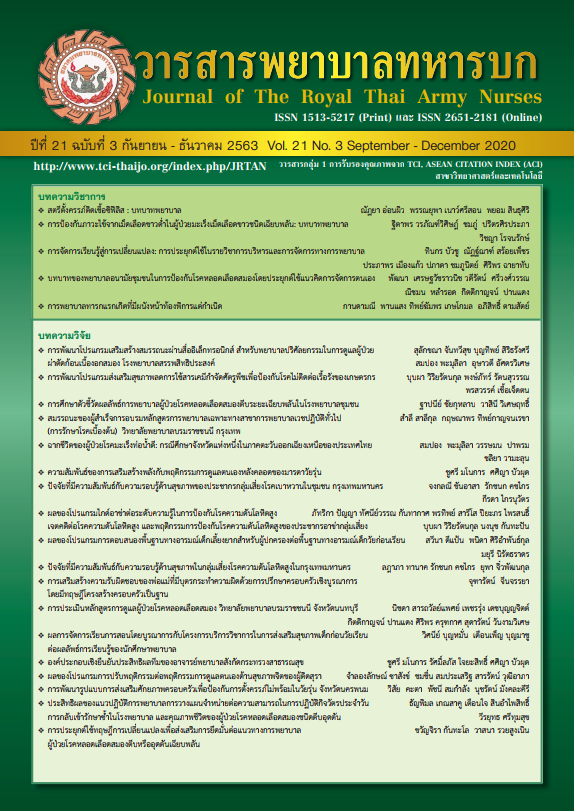Effect of Text Messaging on Food Consumption Behavior and Change of Hemoglobin Level in Pregnant Women with Iron Deficiency Anemia
Keywords:
Text Messaging, Food Consumption Behavior, Pregnant Women, Iron Deficiency AnemiaAbstract
This quasi-experimental research aimed at determining effect of text messaging on food consumption behaviour and change of hemoglobin level in pregnant women with iron deficiency anemia visiting the antenatal care unit at Vajira Hospital, Bangkok. Sample was comprised of 40 pregnant women with iron deficiency anemia. Divided into experimental group and control group, 20 persons per group. They were match-paired by age and parity. The control group received routine care, while the experimental group received routine care and the text messages. Hemoglobin was measured 2 weeks after the intervention. Data were analyzed by frequency, percentage, mean, standard deviation, Chi-Square test, and t-test.
The findings reveal that the experimental group had significantly higher mean difference scores of food consumption behaviour than the control group (t = 6.96, p < .05).Mean hemoglobin in the experimental group was statistically and significantly higher than the control group (t = 2.54, p < .05).The change of hemoglobin level in the experimental group was statistically higher than the control group (t = 3.35, p < .05). The results suggest that the text messaging is effective in reducing the iron deficiency anemia in pregnant women.
Downloads
References
Strategy and Planning Division, Office of the Permanent Secretary. Public Health Statistics. Bangkok: The Printing Office of The War Veterans Organization of Thailand. 2016. (In Thai)
World Health Organization. World health statistics 2016: monitoring health for the SDGs, sustainable development goals. 2016.
Piammongkol S, Chongsuvivatwong V, Williams G, Pornpatkul M. The prevalence and determinants of iron deficiency anemia in rural Thai-Muslim pregnant women in Pattani Province. The Southeast Asian journal of tropical medicine and public health. 2006;37(3):553-8.(In Thai)
Department of Health, Ministry of Public Health. Guide for control and prevention of iron deficiency anemia. Nonthaburi: Department of Health, Ministry of Public Health. 2013. (In Thai)
Banhidy F, Acs N, Puho EH, Czeizel AE. Iron deficiency anemia: pregnancy outcomes with or without iron supplementation. Nutrition (Burbank, Los Angeles Country, Calif). 2011;27(1):65-72.
Reproductive Health, Department of Health, Ministry of Public Health. National Reproductive Health Development Policy and Strategy No.2 (2017-2026). Nonthaburi: Department of Health, Ministry of Public Health. 2017. (In Thai)
Michie S, Free C, West R. Characterising the ‘Txt2Stop’ Smoking Cessation Text Messaging Intervention in Terms of Behaviour Change Techniques. Journal of Smoking Cessation. 2012;7.
Dodd JM, Turnbull D, McPhee AJ, Deussen AR, Grivell RM, Yelland LN, et al. Antenatal lifestyle advice for women who are overweight or obese: LIMIT randomised trial. BMJ (Clinical research ed). 2014;348:g1285.
Munro S, Hui A, Salmons V, Solomon C, Gemmell E, Torabi N, et al. SmartMom Text Messaging for Prenatal Education: A Qualitative Focus Group Study to Explore Canadian Women’s Perceptions. 2017. e7 p.
Evans WD, Abroms LC, Poropatich R, Nielsen PE, Wallace JL. Mobile health evaluation methods: the Text4baby case study. Journal of health communication. 2012;17 Suppl 1:22-9.
Speciale AM, Freytsis M. mHealth for midwives: a call to action. Journal of midwifery & women’s health. 2013;58(1):76-82.
Deelert E& Prajaknate P.Effects of innovative communication on the topic of overweight towards knowledge, attitude and practices of upper primary school students. In National Research Conference 2015, Graduate School of Communication Arts and Innovation Management.Bangkok: National Institute of Development Administration.2015; 18-37. (In Thai)
Muench F, Weiss RA, Kuerbis A, Morgenstern J. Developing a theory driven text messaging intervention for addiction care with user driven content. Psychology of addictive behaviors : journal of the Society of Psychologists in Addictive Behaviors. 2013; 27(1):315-321.
Butpunya Y, Uthis P, Suktrakul S. The Effect of Countinuing Motivational Interviewing Telephone – Based Program on Alcohol Consumption in Person with Alcohol Dependence. Journal of The Royal Thai Army Nurses. 2016;17(3):123-131.(In Thai)
Khorshid MR, Afshari P, Abedi P. The effect of SMS messaging on the compliance with iron supplementation among pregnant women in Iran: a randomized controlled trial. Journal of telemedicine and telecare. 2014;20(4):201-206.
Thaweekhoon R & Pearkao C. Effects of a Smartphone Application on Knowledge Discharge Outcome among Patients with Mild Traumatic Brain Injury. Journal of The Royal Thai Army Nurses. 2019;20(2):272-279.(In Thai)
Downloads
Published
How to Cite
Issue
Section
License
บทความหรือข้อคิดเห็นใดใดที่ปรากฏในวารสารพยาบาลทหารบกเป็นวรรณกรรมของผู้เขียน ซึ่งบรรณาธิการหรือสมาคมพยาบาลทหารบก ไม่จำเป็นต้องเห็นด้วย
บทความที่ได้รับการตีพิมพ์เป็นลิขสิทธิ์ของวารสารพยาบาลทหารบก
The ideas and opinions expressed in the Journal of The Royal Thai Army Nurses are those of the authors and not necessarily those
of the editor or Royal Thai Army Nurses Association.






